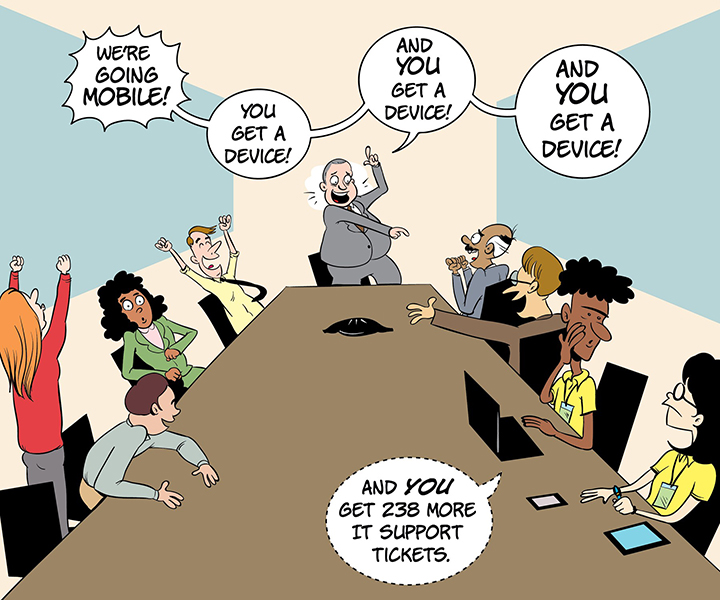When a business deploys hundreds or thousands of mobile devices to its employees, the investment is more than just purchasing devices and delivering cellular connectivity; it also includes the IT resources to support devices and apps throughout their life cycle.
Mobile deployments are more than just hardware; they’re part of a total digital transformation, freeing your business from desktop-bound apps and manual, paper-based workflows. To ensure a successful mobile deployment, you need a reliable partner who knows where the potholes are and how best to avoid them.
Samsung addresses this need with its Knox Suite device management solutions and Enterprise Edition mobile devices like the Galaxy S21 5G and Galaxy Tab Active3.
Here are six common pitfalls of businesses’ mobile deployments and how Samsung’s Enterprise Edition helps you avoid them:
1. Convoluted device enrollment
Deploying a mobile fleet in a corporate environment isn’t always as simple as the out-of-the-box startup that consumers enjoy. On the business side, IT can easily get mired in manually enrolling devices in a mobile device management (MDM) solution.
Samsung’s Enterprise Edition solves that with a free year of Knox Suite, an end-to-end tool kit for securing, deploying and managing mobile devices. With Knox Mobile Enrollment (KME) — included in Knox Suite — IT admins have a zero-touch option to bulk enroll hundreds or even thousands of mobile devices in an MDM. You can also enroll devices in low-bandwidth locations with KME Direct. From day one of your deployment, your team will be ready to get to work on their new devices.
2. Insufficient security
By now, most everyone knows the best practices for mobile security: You have to enforce the use of strong passwords (and preferably use biometrics), block apps from unknown sources and ensure that lost or stolen devices can be wiped remotely. But your devices also need a solid foundation to support these features.
Samsung smartphones are built on the defense-grade Knox security platform, which protects your data at both the hardware and software level. And on Enterprise Edition devices like the S21 and Tab Active3, Samsung has committed to providing five years of guaranteed security maintenance releases, from the date of first availability.
Other solutions within Knox Suite include Knox Manage, Samsung’s comprehensive enterprise mobility management (EMM) solution, which allows you to establish device policies and conduct remote troubleshooting, as well as Knox Platform For Enterprise (KPE), which offers advanced capabilities for data encryption and granular device monitoring and management, so you can set security parameters from top to bottom on all company devices.

3. Incompatible firmware updates
Most IT managers don’t realize firmware updates are a problem until a version update via firmware over-the-air (FOTA) triggers compatibility issues with a key business app. Knox Suite on Enterprise Edition devices gives IT control of firmware updates across the device fleet through Knox E-FOTA. Accessed via Knox Manage and other leading EMMs, the E-FOTA tool allows IT managers to test, schedule or postpone firmware updates as needed.
4. Lack of suitable apps and industry expertise
Enterprise Edition devices like the Galaxy S21 offer built-in Microsoft integration, so employees have access to essential productivity apps like Word, Excel and PowerPoint. Meanwhile, Samsung DeX allows both S21 and Tab Active3 users to enjoy a PC-like experience powered by their mobile device, just by connecting to an external display.
For many enterprise customers, the real challenge is effectively harnessing mobile devices to solve specific business problems. Maybe you want to ensure your organization is ready to pivot to remote work when the need arises. Or maybe you want to take advantage of 5G while capitalizing on emerging mobility trends related to data security and workplace safety. What you need are industry-specific apps built to address these specific challenges. Samsung has the technology partners and the in-house expertise to guide you through the process.
5. Poor visibility into device and app usage
Even if employees’ devices are fully configured with all the right business apps, anything can happen once the team starts using them on the job. Unfortunately, this is the point where IT is usually left in the dark.
It’s often up to employees to report back if, for instance, their apps keep crashing, they’re having Wi-Fi connectivity issues or their battery tends to die before the end of their shift. If nothing happens to fix the situation, your team may revert to manual, error-prone processes, and productivity will suffer.
Mobile device management for beginners
Get started with MDM so your organization can spend less and do more — securely and efficiently. Download Now
Knox Suite solves these visibility problems with Knox Asset Intelligence (KAI), which provides real-time analytics to IT through a cloud-based console that monitors the state of their entire device fleet, so IT can spot abnormal events that stem from business apps or device malfunctions. KAI also helps IT manage devices’ battery health so your team gets the power they need. You can even use KAI to find the root cause of Wi-Fi connectivity issues, or use GPS-based location tracking to help employees find lost devices.
6. No long-term availability
Once your mobile initiative is running smoothly, you may decide you want to add more devices so you can expand your fleet to additional user groups. With new device models being launched every six months, enterprise customers sometimes find themselves unable to repurchase the model they’ve already deployed. Enterprise Edition devices mitigate that risk with product life cycle assurance, guaranteed for two years after launch (three years for the Tab Active3). So if you end up needing to expand your fleet, you can rest assured the same model will still be available.
Investing in enterprise mobility — the right way
There are, of course, other potential pitfalls along the way to a successful mobile deployment. Choosing the right MDM or EMM is critical, as is establishing employee usage policies and providing adequate training. In regulated industries, businesses should also secure their data in transit with a mobile VPN.
Mobile initiatives are often undertaken without a clear roadmap or adequate resources. As a result, IT teams become overwhelmed dealing with device deployment, management and troubleshooting. Perhaps worse, organizations have less time to work on the strategic initiatives that mobile technology should be opening up for them.
In other cases, CIOs have chosen to accept a Bring Your Own Device (BYOD) policy to avoid the expected costs and complications of corporate-owned devices. But BYOD inevitably lessens your enterprise’s ability to leverage mobile workflows. And with less control over your device management, you also face increased security risks.
When you’re deploying dozens, hundreds or thousands of phones to employees, you need solutions you can rely on. The S21 and Tab Active3 Enterprise Edition devices provide a strong platform to support your mobile initiatives — and drive your business forward.
Learn more about how Knox Suite gives you the end-to-end mobile management and security solutions you need to keep your business running. And if you’re just getting started with your MDM — or want some tips on how to streamline your processes — this free beginner’s guide can help.






